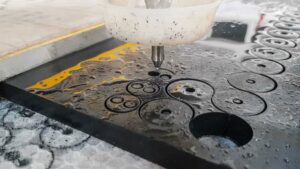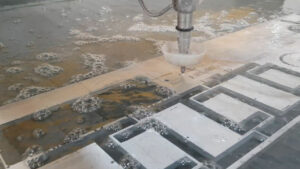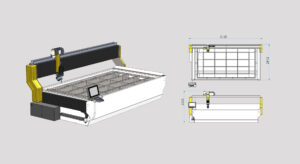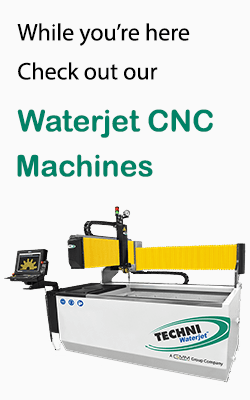Recent years have seen Industrial processes incline towards green technologies. Waterjet cutting is one of the most common industrial cutting techniques. Therefore, manufacturers often question, ‘is water jet cutting environmentally friendly?’
This article will answer this question and explore the environmental impact of waterjet cutting:
Overview of Water Jet Cutting
The Waterjet cutting process uses a water stream at extremely high pressure to pierce materials. The width of the water jet is smaller than human hair. The resulting force is enough to cut even the hardest metals and alloys. Fine abrasive particles are also added to the water stream to aid in the cutting action and speed up the process.
Waterjet cutting is a widely adopted industrial technology. It has no limits to the thickness that can be cut. Additionally, it is versatile and can cut through any material. These reasons have made it the preferred cutting tool for professionals across multiple sectors like medical, agriculture, defense, architecture, fabrication, automotive, etc.
Is Water Jet Cutting Technology Environmentally Friendly?
Yes, waterjet cutting is a completely environmentally friendly process. This includes both pure and abrasive water jet cutting. In fact, waterjet technology is the greenest process when compared with alternatives. There are many reasons to support this, such as:
Recycled Water
Waterjet cutting is a closed-loop process. The water consumed during cutting is drained and reused over and over. There is no waste water in waterjet cutting. This is one of the most crucial environmental benefits of this technology. Other cutting processes use disposable tools you must throw away after a breakdown.
Reduced Waste
Waterjet cutting generates a lesser amount of waste as compared to traditional cutting methods. The material removed during cutting gets dissolved in the water. This material can be strained and recycled later. This makes waterjet cutting a highly efficient process.
No Coolants and Lubricants
Waterjet cutting does not require mineral oil or other environmentally harmful materials as lubricants or coolants. The lack of coolant is because the water used in the process is a coolant. The lack of lubricant is attributed to the fact that water is self-lubricating, unlike mechanical cutting systems.
Healthier Work Environment
There are no noxious fumes or material dust in the work environment using waterjet cutting. This means that the workforce can operate in a safer space. It also eliminates the emission of toxic gases in the atmosphere.
No Hazardous Waste
Hot-cutting processes such as laser and EDM create molten material known as slag. This is an unusable and toxic material. However, waterjet cutting does not produce any hazardous leftovers. The leftover is the material dust dissolved in the water. It is hazardous only if the material you are cutting is hazardous. When cutting these hazardous materials, check in with the local environmental laws for compliance.
Reduction in Transportation Carbon Footprint
Large components require large-scale transportation, such as mega trucks, which release high carbon emissions into the atmosphere. Waterjet cutters can cut these large workpieces into smaller parts. The smaller parts can be easily transported together on a smaller transport.
Reduced Energy Consumption
Waterjet cutting machines consume less energy overall due to their automated nature and lack of physical heat loss. Additionally, components cut with waterjet cutting do not require secondary finishing. This further saves the energy consumption of the process.
Lower Part Rejections
Waterjet cutting has a lower part rejection rate than other cutting processes. This is due to the high precision of this technology and the lack of thermal processes involved. The lack of rejections decreases the amount of wastage caused.
Lesser Noise Pollution
Waterjet technology brings the option of underwater cutting, which significantly reduces the noise of the entire operation. Underwater cutting causes a noise level of 75 dB. For perspective, normal room conversations occur at around 60 dB, and vacuum cleaners create around 80 dB. Therefore, underwater cutting is considered a quiet operation by industrial standards.
Organic Abrasives
Waterjet cutting most commonly relies on garnet abrasive. Garnet is a naturally occurring mineral formation found in abundance in the earth’s surface. Therefore, using this abrasive does not harm the environment in any way.
Efficiency
There is a high degree of automation in waterjet technology. The equipment consumes energy only when it is involved in cutting. There is no requirement to warm up the apparatus. This further increases efficiency and helps in reducing energy requirements.
Mitigating the Environmental Impact of Waterjet Cutters
The abovementioned factors clearly depict how waterjet cutting is a great fit for an environmentally cautious setup. The environmental impact of waterjet cutting technology can be increased even further by adopting equipment like:
Waterjet Cutter Chiller
The waterjet cutter and the workpiece do not face any thermal effects during the cutting process. However, the pump that generates the high pressure is prone to heating. Using a waterjet chiller helps in keeping things in control at this end. With a waterjet chiller, the pump remains at a safe temperature. This reduces heat losses and prolongs the life of internal pump components like seals. It can be helpful if you want to go in the green direction.
Closed-Loop Filtration System
Closed-loop filtration systems collect the used water and treat it. The treated water is then fed back into the system. This reduces water wastage by a huge factor and reduces the water requirement for the operation. These systems do the job of filtering the water and fixing it for hardness.
Abrasive Removal System
An abrasive removal system automatically filters out the abrasive sludge from the water. The removed abrasive can be reused after proper treatment or disposed of properly. This leads to a waterjet system emitting zero pollutants into the environment.
Techni Waterjet- The Green Initiative
All Techni CNC waterjet machines are designed to be completely environmentally friendly options. Organizations that focus on green technologies prefer Techni Waterjet as their supplier for industrial cutters. These machines are sturdy and designed to last longer than any other alternative. This leads to less frequent breakdowns and lower waste generation.
Additionally, all Techni Waterjet cutters are fitted with automated control and compatible software. This keeps the machine’s operation efficient, saving energy costs. The machines include underwater cutting and multi-stage water filters to eliminate draining any polluted water.
Conclusion
Waterjet cutting is the best solution from an environmental perspective. In this regard, hardly any cutting method outperforms traditional water jet cutting. Waterjet cutting is the way to go if you are looking for green technology to fulfill your cutting requirements.





